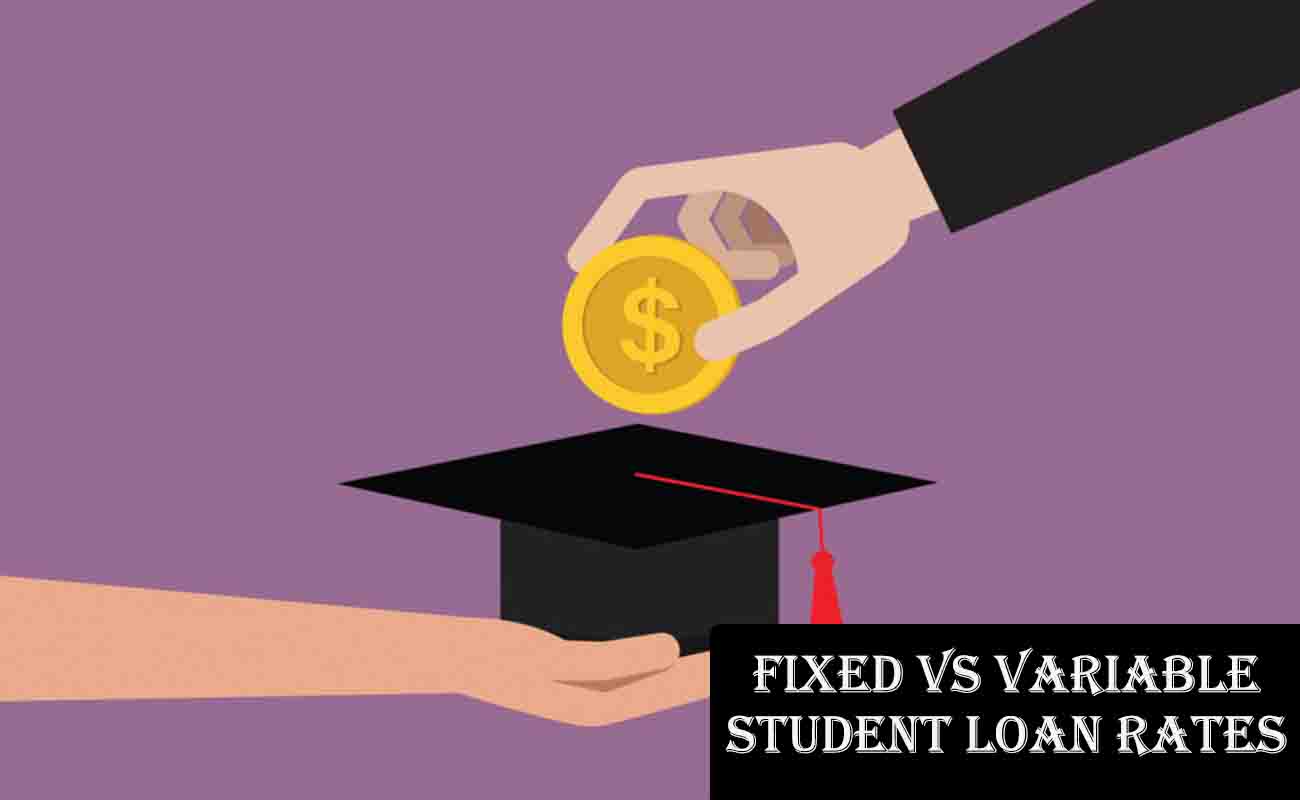Fixed vs Variable Student Loan Rates: Which is Bettter? As someone who helps people navigate financial decisions, I often get asked about the differences between fixed and variable student loan rates. This choice can significantly impact your monthly budget and the total cost of your education over time.

In this guide, I’ll break down what fixed and variable student loan rates are, their advantages and disadvantages, and how you can choose the best option for your financial situation. Whether you’re a student planning for college or a graduate considering refinancing, understanding these rates will help you make an informed decision.
Introduction to Student Loan Rates
Student loans are a common way to fund higher education, but the interest rate you choose can make a big difference in how much you ultimately pay. Fixed and variable rates are the two main types of interest rates available, particularly with private student loans.
Federal loans, on the other hand, always come with fixed rates. The decision between fixed and variable rates depends on your financial goals, repayment timeline, and comfort with risk. Let’s dive into what each type means and how they work.
Fixed vs Variable Student Loan Rates
When you take out a student loan, the interest rate determines the cost of borrowing. Here’s a quick overview of the two types:
- Fixed Interest Rate: This rate remains constant throughout the life of your loan. Your monthly payments remain consistent, making budgeting easier. For example, a $30,000 loan at a 5.50% fixed rate over 10 years would cost $9,069.41 in interest, with a monthly payment of $325.58.
- Variable Interest Rate: This rate fluctuates based on market conditions, typically tied to an index such as the Secured Overnight Financing Rate (SOFR). Your payments might start lower but could increase or decrease over time. For instance, private lenders like College Ave offer variable rates starting at 4.24%, compared to fixed rates at 3.24% or higher.
The choice between these rates depends on your financial situation, how long you’ll take to repay, and whether you’re comfortable with potential payment fluctuations.
What Are Fixed Student Loan Rates?
Fixed student loan rates are interest rates that remain constant throughout the loan term. Once you sign the loan agreement, the rate is locked in, and it only changes if you refinance or consolidate the loan. This predictability makes fixed rates a popular choice for many borrowers.
Benefits of Fixed Rates
- Predictable Payments: Your monthly payment stays the same, making it easier to plan your budget. For example, a $30,000 loan at 5.50% over 10 years means you’ll always pay $325.58 monthly.
- Protection Against Rate Increases: If market interest rates rise, your fixed rate won’t, shielding you from higher payments.
- Ideal for Long-Term Loans: For loans with repayment periods of 10 years or more, fixed rates reduce the risk of market fluctuations.
Drawbacks of Fixed Rates
- Higher Starting Rates: Fixed rates often start higher than variable rates. For instance, Sallie Mae offers fixed rates from 3.45% to 16.49%, while variable rates start at 4.37%.
- No Benefit from Rate Drops: If market rates fall, you’re stuck with your higher fixed rate unless you refinance.
When to Choose Fixed Rates
Fixed rates are likely a good fit if:
- You have a long repayment term (e.g., 10+ years).
- You value predictable payments for budgeting.
- You expect interest rates to rise based on economic trends.
What Are Variable Student Loan Rates?
Variable student loan rates can change over time, typically tied to a financial index like SOFR. These rates may adjust monthly, quarterly, or annually, depending on the lender’s terms, which means your monthly payments can fluctuate.
Benefits of Variable Rates
- Lower Initial Rates: Variable rates often start lower than fixed rates, potentially saving you money early on. For example, Ascent Funding offers variable rates from 4.70% to 15.26%.
- Potential Savings: If market rates decrease, your payments could go down, reducing the total cost of your loan.
- Good for Short-Term Loans: If you plan to pay off your loan quickly, you might benefit from lower initial rates before significant rate changes occur.
Drawbacks of Variable Rates
- Unpredictable Payments: If rates rise, your monthly payments could increase, making budgeting harder. Some lenders cap rates (e.g., up to 25%), but you should check the terms.
- Higher Long-Term Risk: Over a long repayment period, variable rates could lead to higher total costs if rates increase significantly.
When to Choose Variable Rates
Variable rates might be suitable if:
- You plan to pay off your loan quickly (e.g., within 5 years).
- You have a high credit score (670 or above), which can secure lower initial rates.
- You’re comfortable with the risk of payment increases and have budget flexibility.
Fixed vs. Variable: Key Differences
Here’s a table summarizing the key differences between fixed and variable student26 student loan rates:
| Aspect | Fixed-Rate Student Loans | Variable-Rate Student Loans |
|---|---|---|
| Rate Stability | Locked in for the loan term | Can change based on market conditions (e.g., SOFR) |
| Predictability | Consistent monthly payments | Payments can fluctuate |
| Starting Rates | Generally higher (e.g., 3.24%-17.99%) | Often lower (e.g., 4.24%-17.99%) |
| Total Cost | Predictable interest cost | Varies with rate changes |
| Risk | Lower risk, no rate increases | Higher risk, rates may rise |
This table highlights the trade-offs: fixed rates offer certainty but may cost more initially, while variable rates offer potential savings but carry uncertainty.
How to Choose Between Fixed and Variable Rates
Choosing between fixed and variable student loan rates depends on your financial situation and goals. Here are some factors to consider:
- Repayment Timeline: Longer loans (10+ years) are riskier with variable rates due to potential rate hikes. Fixed rates are safer for extended terms.
- Credit Score: A good credit score (670+) can secure lower variable rates, but fixed rates might be better for those with lower scores.
- Market Conditions: If rates are high when you borrow, a variable rate might decrease later, but predicting market trends is challenging.
- Risk Tolerance: If you prefer stability, fixed rates are better. If you’re okay with some uncertainty for potential savings, variable rates might work.
For example, if you’re a recent graduate with a stable job and plan to pay off a $20,000 loan in 5 years, a variable rate starting at 4.24% could save you money if rates stay low. But if you’re on a tight budget with a 15-year loan, a fixed rate at 5.50% ensures your payments won’t spike unexpectedly.
Federal vs. Private Student Loans
Federal student loans, offered by the U.S. Department of Education, always have fixed rates, set annually by Congress. For 2023-2024, rates are 5.50% for undergraduate Direct Subsidized/Unsubsidized Loans, 7.05% for Graduate Unsubsidized Loans, and 8.05% for PLUS Loans (Federal Student Aid).
These loans come with benefits like income-driven repayment and forgiveness programs, making them a priority. Private student loans, from lenders like banks, offer both fixed and variable rates. Rates depend on your credit score, income, and debt-to-income ratio. Private loans lack federal protections, so exhaust federal options first.
FAQs
- Can I switch from a variable-rate loan to a fixed-rate loan?
Yes, you can refinance to switch to a fixed rate, but refinancing federal loans into private ones means losing federal benefits like forgiveness programs. - What happens if interest rates rise on my variable-rate loan?
Your monthly payments could increase, raising the loan’s total cost. Check your lender’s rate cap (e.g., 25%) to understand the maximum potential rate. - Are variable-rate loans ever a good choice?
They can be if you plan to pay off the loan quickly or expect rates to drop, but they’re riskier for long-term loans. - How do I qualify for the best rates?
A credit score of 670 or higher typically secures the lowest rates. Lower scores may require a cosigner or result in higher rates.
Conclusion
Choosing between fixed and variable student loan rates is a personal decision that depends on your financial situation and risk tolerance. Fixed rates offer stability and predictability, which is invaluable for long-term planning, while variable rates might offer lower initial payments but come with the uncertainty of potential increases.
Start with federal loans for their fixed rates and benefits, then consider private loans if needed. Compare rates from lenders like Sallie Mae or College Ave and consult a financial advisor to make the best choice for your future.
Key Citations
- NerdWallet: Fixed or Variable Student Loan
- Bankrate: Fixed vs. variable student loan rates
- US News: Should You Get a Fixed- or Variable-Rate Student Loan?
- Federal Student Aid: Interest Rates for Federal Loans
- Sallie Mae: Student Loan Options
- College Ave: Undergraduate Student Loans
- Ascent Funding: Student Loan Application
